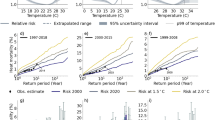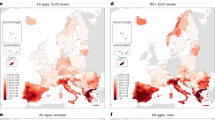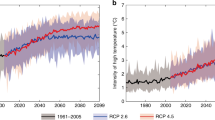Abstract
Climate change affects human health; however, there have been no large-scale, systematic efforts to quantify the heat-related human health impacts that have already occurred due to climate change. Here, we use empirical data from 732 locations in 43 countries to estimate the mortality burdens associated with the additional heat exposure that has resulted from recent human-induced warming, during the period 1991–2018. Across all study countries, we find that 37.0% (range 20.5–76.3%) of warm-season heat-related deaths can be attributed to anthropogenic climate change and that increased mortality is evident on every continent. Burdens varied geographically but were of the order of dozens to hundreds of deaths per year in many locations. Our findings support the urgent need for more ambitious mitigation and adaptation strategies to minimize the public health impacts of climate change.
This is a preview of subscription content, access via your institution
Access options
Access Nature and 54 other Nature Portfolio journals
Get Nature+, our best-value online-access subscription
$29.99 / 30 days
cancel any time
Subscribe to this journal
Receive 12 print issues and online access
$209.00 per year
only $17.42 per issue
Buy this article
- Purchase on Springer Link
- Instant access to full article PDF
Prices may be subject to local taxes which are calculated during checkout





Similar content being viewed by others
Data availability
An example dataset is made available from https://github.com/anavica/mcc_ccattr_NCC and archived in the open repository ‘BORIS’ of the University of Bern under https://doi.org/10.48350/155666.
Code availability
A sample of the code to reproduce the analysis is made available from https://github.com/anavica/mcc_ccattr_NCC and archived in the open repository ‘BORIS’ of the University of Bern under https://doi.org/10.48350/155666.
References
IPCC Special Report on Global Warming of 1.5 °C (eds Masson-Delmotte, V. et al.) (WMO, 2018).
Gasparrini, A. et al. Mortality risk attributable to high and low ambient temperature: a multicountry observational study. Lancet 386, 369–375 (2015).
Hsiang, S. et al. Estimating economic damage from climate change in the United States. Science 356, 1362–1369 (2017).
Ye, X. et al. Ambient temperature and morbidity: a review of epidemiological evidence. Environ. Health Perspect. 120, 19–28 (2012).
IPCC Climate Change 2014: Synthesis Report (eds Core Writing Team, Pachauri, R. K. & Meyer, L. A.) (IPCC, 2014).
Ebi, K. L. et al. Health risks of warming of 1.5 °C, 2 °C, and higher, above pre-industrial temperatures. Environ. Res. Lett. 13, 063007 (2018).
Bindoff, N. L. et al. in Climate Change 2013: The Physical Science Basis (eds Stocker, T. F. et al.) 867–952 (Cambridge Univ.Press, 2013).
Cramer, W. et al. in IPCC Climate Change 2014: Impacts, Adaptation, and Vulnerability (eds Field, C. B. et al.) 979–1037 (Cambridge Univ. Press, 2014).
Ebi, K. L., Ogden, N. H., Semenza, J. C. & Woodward, A. Detecting and attributing health burdens to climate change. Environ. Health Perspect. 125, 085004 (2017).
Mitchell, D. et al. Attributing human mortality during extreme heat waves to anthropogenic climate change. Environ. Res. Lett. 11, 074006 (2016).
Christidis, N., Mitchell, D. & Stott, P. A. Anthropogenic climate change and heat effects on health. Int. J. Climatol. 39, 4751–4768 (2019).
Gasparrini, A. Modeling exposure-lag-response associations with distributed lag non-linear models. Stat. Med. 33, 881-899 (2014).
Gasparrini, A. & Armstrong, B. Reducing and meta-analysing estimates from distributed lag non-linear models. BMC Med. Res. Methodol. 13, 1 (2013).
Sera, F., Armstrong, B., Blangiardo, M. & Gasparrini, A. An extended mixed-effects framework for meta-analysis. Stat. Med. 38, 5429–5444 (2019).
Vicedo-Cabrera, A. M., Sera, F. & Gasparrini, A. Hands-on tutorial on a modeling framework for projections of climate change impacts on health. Epidemiology 30, 321–329 (2019).
Gasparrini, A. & Leone, M. Attributable risk from distributed lag models. BMC Med. Res. Methodol. 14, 55 (2014).
Gillett, N. P. et al. The detection and attribution model intercomparison project (DAMIP v1.0) contribution to CMIP6. Geosci. Model Dev. 9, 3685–3697 (2016).
Gillett, N. P. et al. Constraining human contributions to observed warming since preindustrial. Nat. Clim. Change 11, 207–212 (2021).
Hempel, S., Frieler, K., Warszawski, L., Schewe, J. & Piontek, F. A trend-preserving bias correction—the ISI-MIP approach. Earth Syst. Dynam. 4, 219–236 (2013).
Gasparrini, A. et al. Changes in susceptibility to heat during the summer: a multicountry analysis. Am. J. Epidemiol. 183, 1027–1036 (2016).
Åström, D. O., Forsberg, B., Ebi, K. L. & Rocklöv, J. Attributing mortality from extreme temperatures to climate change in Stockholm, Sweden. Nat. Clim. Change 3, 1050–1054 (2013).
Basu, R. High ambient temperature and mortality: a review of epidemiologic studies from 2001 to 2008. Environ. Health 8, 40 (2009).
Benmarhnia, T., Deguen, S., Kaufman, J. S. & Smargiassi, A. Vulnerability to heat-related mortality: a systematic review. Epidemiology 26, 781–793 (2015).
Gasparrini, A. et al. Temporal variation in heat-mortality associations: a multicountry study. Environ. Health Perspect. 123, 1200–1207 (2015).
Vicedo-Cabrera, A. M. et al. A multi-country analysis on potential adaptive mechanisms to cold and heat in a changing climate. Environ. Int. 111, 239–246 (2017).
Rogelj, J. et al. Paris Agreement climate proposals need a boost to keep warming well below 2 °C. Nature 534, 631–639 (2016).
Gasparrini, A. et al. Projections of temperature-related excess mortality under climate change scenarios. Lancet Planet. Health 1, e360–e367 (2017).
Vicedo-Cabrera, A. M. et al. Temperature-related mortality impacts under and beyond Paris Agreement climate change scenarios. Climatic Change 150, 391–402 (2018).
Kottek, M., Grieser, J., Beck, C., Rudolf, B. & Rubel, F. World Map of the Köppen–Geiger climate classification updated. Meteorol. Z. 15, 259–263 (2006).
Gasparrini, A., Armstrong, B. & Kenward, M. G. Multivariate meta-analysis for non-linear and other multi-parameter associations. Stat. Med. 31, 3821–3839 (2012).
Gasparrini, A. Distributed lag linear and non-linear models in R: the package dlnm. J. Stat. Softw. 43, 1–20 (2011).
Acknowledgements
We thank the participants of the ISIMIP Health workshop in Barcelona in November 2018 where this work was discussed for the first time. This study was supported by the Medical Research Council UK (grant no. MR/M022625/1), the Natural Environment Research Council UK (grant no. NE/R009384/1) and the European Union’s Horizon 2020 Project Exhaustion (grant no. 820655). N.S. was supported by the NIEHS-funded HERCULES Center (P30ES019776). Y.H. was supported by the Environment Research and Technology Development Fund of the Environmental Restoration and Conservation Agency, Japan (JPMEERF15S11412). J.J.J.K.J. was supported by Academy of Finland (grant no. 310372). V.H. was supported by the Spanish Ministry of Economy, Industry and Competitiveness (grant no. PCIN-2017-046) and the German Federal Ministry of Education and Research (grant no. 01LS1201A2). J.K. and A.U. were supported by the Czech Science Foundation (grant no. 20-28560S). J.M. was supported by the Fundação para a Ciência e a Tecnologia (FCT) (SFRH/BPD/115112/2016). S.R. and F.d.R. were supported by European Union’s Horizon 2020 Project EXHAUSTION (grant no. 820655). M.H. was supported by the Japan Science and Technology Agency as part of SICORP, grant no. JPMJSC20E4. Y.G. was supported by the Career Development Fellowship of the Australian National Health and Medical Research Council (APP1163693). S.L. was support by the Early Career Fellowship of the Australian National Health and Medical Research Council (APP1109193). Y.L.L.G. was supported by the Taiwan Ministry of Science and Technology (MOST110-2918-I-002-007) as a visiting academic at the University of Sydney.
Author information
Authors and Affiliations
Contributions
A.M.V.C., A.G., A.T., C.A., Y.G., D.H., M.M. and V.H. were involved in conceptualization. A.M.V.C., A.G. and F.S. designed the methodology. A.M.V.C. conducted the formal analysis. A.M.V.C., N.G., N.S., F.S., D.R., R.S.D.S., A.T., C.A., Y.G., Y.H., R.A., S.T., M.S.Z.S.C., P.H.N.S., E.L., P.M.C., M.V.O., H.K., S.O., J.K., A.U., H.O., E.I., J.J.J.K.J., N.R., M.P., A.S., K.K., A.A., F.M., A.E., P.G., A.Z., P.M., F.D., M.H., B.A., M.H.D., C.D.V., A.O., D.H., C.A., S.R., F.d.R., G.C.E., X.S., S.S., J.M., I.H.H., S.F., F.A., H.K., W.L., C.I., B.F., M.S.R., Y.L.L.G., B.Y.C., S.L., B.A., A.A., A.Z., J.S., T.N.D., D.V.D. and M.M. were involved in resources and data curation. A.M.V.C., D.R. and N.S. undertook visualization. A.M.V.C., A.G. and N.S. wrote the draft manuscript. A.H., A.M.V.C., N.S., F.S., D.R., R.S.D.S., A.T., C.A., Y.G., Y.H., R.A., S.T., M.S.Z.S.C., P.H.N.S., E.L., P.M.C., M.V.O., H.K., S.O., J.K., A.U., H.O., E.I., J.J.J.K.J., N.R., M.P., A.S., K.K., A.A., F.M., A.E., P.G., A.Z., P.M., F.D., M.H., B.A., M.H.D., C.D.V., A.O., D.H., C.A., S.R., F.d.R., G.C.E., X.S., S.S., J.M., I.H.H., S.F., F.A., H.K., W.L., C.I., B.F., M.S.R., Y.L.L.G., B.Y.C., S.L., B.A., A.A., A.Z., J.S., T.N.D., D.V.D., M.M. and D.H. were involved in revising the manuscript. A.G. supervised the project.
Corresponding authors
Ethics declarations
Competing interests
The authors declare no competing interests.
Additional information
Peer review information Nature Climate Change thanks Katrin Burkart, Daniel Mitchell and the other, anonymous, reviewer(s) for their contribution to the peer review of this work.
Publisher’s note Springer Nature remains neutral with regard to jurisdictional claims in published maps and institutional affiliations.
Extended data
Extended Data Fig. 1 Time series plots of the warm-season mean daily temperatures in each scenario provided by each model.
The time series plots depict the temporal trends in average warm-season temperatures across the 732 locations included in the study. Factual scenario (with natural and anthropogenic forcings) is depicted in brown, while counterfactual scenario (with natural forcings only) in orange. The grey dark area corresponds to the study period 1991–2018. (ACC: ACCESS-ESM1-5, CAN: CanESM5, CNR: CESM2, FGO: FGOALS-g3, GFD: GFDL-ESM4, HAD: HadGEM3-GC31-LL, IPS: IPSL-CM6A-LR, MIR: MIROC6, MRI: MRI-ESM2-0, Nor: NorESM2-LM).
Extended Data Fig. 2 Time series plots of the warm-season mean daily temperatures in each scenario in the 43 countries included in the study.
As Fig.1, factual scenario (with natural and anthropogenic forcings) is depicted in brown, while counterfactual scenario (with natural forcings only) in orange. The shaded area corresponds to 1 standard deviation across model-specific average estimates. The dashed line shows the start of the study period (1991–2018).
Extended Data Fig. 3 Country-averaged warm-season temperature distributions modelled in each scenario.
As Fig.1, factual scenario (with natural and anthropogenic forcings) is depicted in brown, while counterfactual scenario (with natural forcings only) in orange.
Extended Data Fig. 4 Location-specific heat-related mortality attributed to human-induced climate change (CC) between 1991–2018.
Map with the location-specific estimates of heat-related mortality fractions attributed to human-induced climate change (expressed in %). Estimates ranged between 0.2% and 0.8%, corresponding to the interquartile range, with a maximum value of 3.8%, and 23 locations reported an estimate below 0 (minimum value of -0.1%).
Extended Data Fig. 5 Proportion of heat-related mortality attributed to human-induced climate change (CC), between 1991–2018.
Map with the location-specific estimates of the proportion of heat-related mortality attributed to human-induced climate change (expressed in %). Estimates ranged between 28.6% and 54.2%, corresponding to the interquartile range, with a maximum value of 92%, and 1 location with estimates below 0 (minimum value of -0.1%).
Extended Data Fig. 6 Model-specific estimates of the heat-related mortality attributed to human-induced climate change (CC) for each country, expressed as mortality fraction (%).
The plot shows the model-specific estimates of heat-related mortality fraction attributed to human-induced climate change for each country (1991–2018). ACC: ACCESS-ESM1-5, CAN: CanESM5, CNR: CESM2, FGO: FGOALS-g3, GFD: GFDL-ESM4, HAD: HadGEM3-GC31-LL, IPS: IPSL-CM6A-LR, MIR: MIROC6, MRI: MRI-ESM2-0, Nor: NorESM2-LM.
Supplementary information
Supplementary Information
Supplementary Tables 1–5.
Rights and permissions
About this article
Cite this article
Vicedo-Cabrera, A.M., Scovronick, N., Sera, F. et al. The burden of heat-related mortality attributable to recent human-induced climate change. Nat. Clim. Chang. 11, 492–500 (2021). https://doi.org/10.1038/s41558-021-01058-x
Received:
Accepted:
Published:
Issue Date:
DOI: https://doi.org/10.1038/s41558-021-01058-x
This article is cited by
-
Recently emerging trends in big data analytic methods for modeling and combating climate change effects
Energy Informatics (2024)
-
Risk factors associated with heatwave mortality in Chinese adults over 65 years
Nature Medicine (2024)
-
The risk of concurrent heatwaves and extreme sea levels along the global coastline is increasing
Communications Earth & Environment (2024)
-
Hourly values of an advanced human-biometeorological index for diverse populations from 1991 to 2020 in Greece
Scientific Data (2024)
-
Exacerbated summer European warming not captured by climate models neglecting long-term aerosol changes
Communications Earth & Environment (2024)



